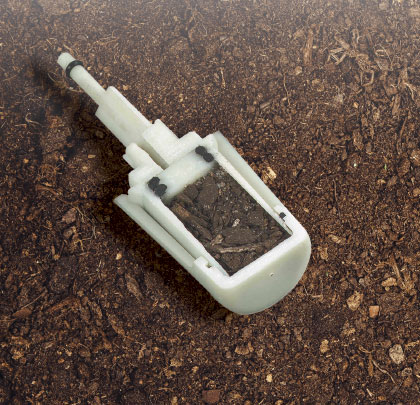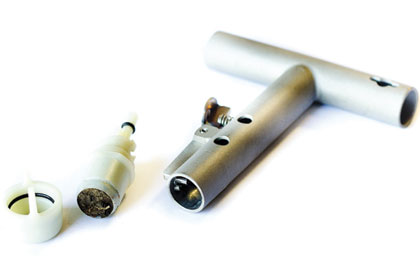As we touched on in part 1 of this series, there are some limitations to low level analysis. Low level analysis is considered to be only semi-quantitative because the aqueous solution used is a poor solvent for soil VOCs, which causes results to be biased low. In addition, high concentrations of acetone can be formed by the preservative itself in some organic-rich soils.
Despite the limitations of low level analysis, sub-core sampling using field preservation techniques is an effective methodology and is widely accepted by regulators. It is an advantageous method for laboratories because it requires no further preparation of samples by the laboratory doing the analysis, and also doesn’t require any special tools or procedures for the laboratory to process samples. In addition, VOC concentrations in samples collected using field preservation remain stable throughout the fourteen-day hold time and beyond.
There are disadvantages to sub-core sampling with field preservation. For example, the seals of the vials used to collect samples can leak causing a loss of preservative or VOCs. Another issue is the need for more experienced field staff, as the process used to collect field preserved sub-core samples is more complicated than other methods and can be even more difficult in adverse conditions. Lastly, shipping restrictions may apply to high level samples as they contain methanol (although this typically is not an issue if the samples are properly labeled and have a volume of less than 500 mL).
THE EN CORE® SAMPLER
The only alternative method to sub-core sampling with field preservation within US EPA Method 5035A is sampling using an En Core sampler. The En Core sampler is the only commercially available sampler listed in Method 5035A, and is both a sampling tool and a sample container. There are three major components to the En Core sampler: the reusable T-handle, which holds the sampler and is used to push it into a soil core, the En Core sampler itself, which is where the soil sample is collected and stored, and the cap, which seals the sampler shut for transport to the lab. Once the sample is collected, excess dirt is cleaned from the sampler upon removing it from the soil, the cap is snapped into place on the sampler, and then the sampler is removed from the T-handle and placed in a pre-labeled VOC-proof bag to be shipped to the lab.
The En Core sampler has several advantages over field preservation and bulk sampling methods. First, because it eliminates transfer of the soil sample into vials and the need to weigh vials in the field, it is faster and easier than other methods, allowing for more sample throughput per day. Additionally, it requires minimal training to use effectively, doesn’t require field staff to handle preservative in the field, and has a long shelf life (no preservative expiration dates to consider). Because there are no preservatives involved in field work using the En Core, there are no sample shipping restrictions, and random error in sample results, which often come from mistakes in field preservation, is much less common. Finally, the En Core samples are shipped to the laboratory in a proprietary VOC-proof bag, which further prevents random error in results. The En Core sampler delivers such consistent results in spite of variations in the experience of the field staff that use it that it is often used to minimize liability concerns.
The En Core sampler is also very reliable—millions of En Cores have been sold without one reported analytical incident. This is in part due to the manufacturing quality standards of the En Core, which are higher than those of sample vials. Every lot of En Core samplers is tested and analyzed for performance and cleanliness, including tests at extremely high and low temperatures. In fact, En Core samples can be stored frozen without any damage.
There are some limitations to the En Core sampler. If the En Core is being used under sampling Method 5035A, the samples must be preserved at the lab within forty-eight hours. Additionally, En Core samples are reported in dry weight, so an extra jar of soil must be collected along with En Core samplers to measure the moisture content of the soil at the laboratory. Lastly, the per-sample cost of using the En Core sampler is higher than that of the field preserved sub-core method, though some of this extra cost is offset by the time savings created by the En Core sampler.
SUMMARY
To collect quality soil samples that will deliver accurate data, one of two different methods of sampling should be used: field preservation of sub-core samples, or sampling using an En Core sampler. While widely used in the past, studies have shown that the bulk sampling method is unreliable and highly prone to sample bias due to VOC losses. Under either of the two viable methods, it is vital to carefully follow the best practices for handling a soil core and sampling from that soil core in order to ensure a quality sample, and in turn, quality VOC data. ◆
David Kaminski is senior vice president at QED Environmental Systems, Inc. QED Environmental Systems is the leading manufacturer of innovative environmental products. For over thirty years their expertise has included pumping systems, landfill products, and air strippers. For more information, visit www.qedenv.com.
____________________________________________
MODERN PUMPING TODAY, February 2018
Did you enjoy this article?
Subscribe to the FREE Digital Edition of Modern Pumping Today Magazine!
![]()



